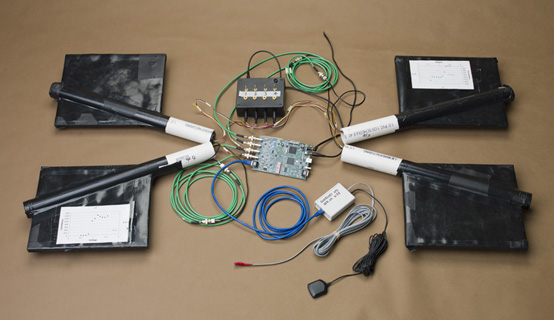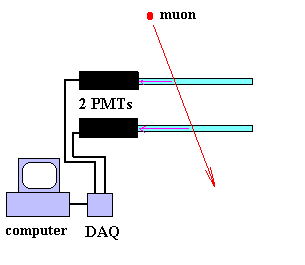 |
QuarkNetter Reports: The Fermilab Detector |
 |

 |
QuarkNetter Reports: The Fermilab Detector |
 |

The Fermilab detector has been under continuous development for some time. Development started a few years ago when Jeff Rylander, then a Fermilab TRAC teacher and now a QuarkNet lead teacher at Argonne National Laboratory, developed a muon lifetime experiment using a single counter—a scintillator mated to a photomultiplier tube (PMT)—and an analog-to-digital data acquisition (DAQ) board designed by Sten Hansen of Fermilab. These sent digital signals to a computer where they were read in hyperterminal and transferred to a spreadsheet for analysis.
In 1999 QuarkNet lead teacher Ed Pascuzzi (SUNY-Stony Brook) picked up the thread while working at Fermilab for the summer. With Sten Hansen's help and money from his school district, Ed built a working muon lifetime experiment to use with his students.
At the same time, the University of Rochester QuarkNet Center (mentor Kevin McFarland and lead teachers Susen Clark and Paul Pavone) developed a muon counting experiment using the same DAQ board and two scintillators. One main activity of the 2000 Associate Teacher Institute was to build a large number of these detectors for classrooms in Rochester-area high schools.
Tom Jordan and his colleagues have continued the development of both the original DAQ and the experiment at Fermilab. They have added an LED readout and low-voltage power supply to the board, and they have added Cockroft-Walton bases to the PMTs. The Cockcroft-Walton base converts the low-voltage ouput from the board to the very high voltages needed to operate the PMTs. These improvements made the detector portable. You can operate it with batteries or a car cigarette lighter. Teachers at the 2001 Lead Teacher Institute assembled this type of muon telescope successfully. The experiment was repeated at the 2001 Fermilab Weekend with good results.
 | Here's how the system works. Plastic or glass scintillator is mated using optical glue and shaped fittings to PMTs. The scintillators are covered with reflective material (aluminum foil works) and then with black paper and tape to make them "light-tight."They are hooked up to the DAQ which feeds into the parallel port of a computer. When a cosmic ray muon passes through the scintillator, it causes a few photons to be emitted by impurities in the scintillator material. These are picked up by the PMTs, converted to an electrical pulse and amplified. Each PMT sends its signal to the DAQ. |
Muon Counting Experiment
When counting muons, the DAQ looks for "coincidences"—two signals (one from each PMT) which are received within a very short time. These are reported to the computer; all other signals are vetoed as likely noise from the PMTs. The computer can count the number of muons that come in over an interval to get a rate count.Muon Lifetime Experiment
Some muons will be of low energy and will lose that energy in the scintillator. Such a muon will remain there for a short time until it decays into an electron and two neutrinos. We cannot detect the neutrinos, but we can detect the electron as it causes a few more photons to be emitted by impurities in the scintillator material. The DAQ measures the time between the "muon signal"and the "electron signal." These double hits and their time intervals are reported to the computer. The data can be fed into a spreadsheet and analyzed to calculate the lifetime of the muon.If you'd like to assemble a Fermilab detector, here's what you ought to do:
There are drawbacks. This detector is like a science experiment—in progress.
- Obtain PMTs. One of the great features of this system is that it does not depend on a particular type of PMT, though it should be fairly fast in its response. This means you can scrounge used PMTs from old experiments and mothballed detectors.
- Obtain scintillator. You can scrounge used scintillator as well.
- Get reflective material, optical glue and fittings to mate your scintillator to your PMT. Eljen Technology and Bicron are good sources for these materials.
- Obtain cables and, most important, the DAQ board. The folks at Fermilab make these at a reasonable cost in lots of 10 or so. Contact Tom Jordan. Of course, you can "roll your own" DAQ. Check the schematic, link below.
- There is one other alternative to the DAQ: experiments of this type have been done for years using NIM electronics. If you have access to a lab with old NIM crates gathering dust, you might be able to use these instead. You'll also need good advice from your mentor on how to use them. We are recommending the DAQ here, but we did want to let you know about the alternative.
- Obtain Cockcoft-Walton bases from Fermilab or use standard PMT bases and look for a high-voltage power supply. If you use a high voltage supply, you'll need a 1500 volt-or-so output. We recommend the Cockcroft-Waltons.
- Prepare to do some work. This detector is still under development and can be tricky. Do not approach your collection of parts as a kit but rather as an experiment requiring some care and a desire to "make it work." Also, get ready to use hexidecimal: both the LED readout and the computer output are in hex rather than standard numbers. (MS Excel has a hex-to-standard conversion routine.)
- Be flexible: your equipment is. Once you get it up and running, you'll find that this type of cosmic ray detector can be used to do a variety of experiments and is open to various modifications. You and your kids can try stuff! That is one of the advantages of this detector. The experiments you do can be more student led, teacher guided.
- You have to want to get your hands dirty and build something with this detector.
- This detector may be more temperamental than others because some components are fragile.
- There is a steep learning curve to understanding the data readout (Fermilab is working on that. Stay tuned.)
RATINGS
|
RESOURCES AND CONTACTSInstructions for set-up and use at the University of Rochester QuarkNet Center Schematic of the latest version of the DAQ board (PDF File). Users Manual prepared by Jeff Rylander; all you need to know and more Pictures of the apparatus built at the 2001 Lead Teacher Institute. Sources for scintillator and other materials: Eljen Technology Bicron Contacts: Tom Jordan has a great deal of practical experience setting up and using the Fermilab detector. |